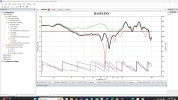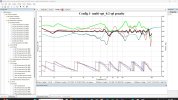I just noticed that the miniDSP Flex HTx has no input biquads. When you're using MSO with SPL maximization or multi-stage optimization, you must use shared sub filters in MSO, which are usually implemented as input biquads in miniDSP devices. Without some sort of workaround for the absence of input biquads in the particular miniDSP device you're using, your MSO biquad export files will contain a file for the miniDSP input channel that doesn't exist. You work around this lack of miniDSP input biquads in MSO by first enabling the crossover biquads as shown in the image of the previous post. Then you tell MSO that the number of input biquads per that image is zero. MSO then implements the shared sub filters as filters that are replicated in each separate miniDSP sub channel. Some or all of these will end up in the crossover biquads. When you do this, the number of shared PEQs plus per-sub PEQs must add up to a maximum of 18 (8 in the crossover biquads, 10 in in the output biquads).
This means you might have 8 shared sub PEQs plus 10 per-sub PEQs, 9 shared shared sub PEQs plus 9 per-sub PEQs, 10 shared shared sub PEQs plus 8 per-sub PEQs and so on. You can't have, say 10 shared sub PEQs plus 10 per-sub PEQs, because that would add up to more than 18 total.
When exporting, you end up with some biquad files ending in "_xo.txt", which must be pasted into the crossover biquads in the miniDSP device console software. If you don't appropriate the crossover biquads in this way, the total number of shared PEQs plus per-sub PEQs is limited to 10.
This means you might have 8 shared sub PEQs plus 10 per-sub PEQs, 9 shared shared sub PEQs plus 9 per-sub PEQs, 10 shared shared sub PEQs plus 8 per-sub PEQs and so on. You can't have, say 10 shared sub PEQs plus 10 per-sub PEQs, because that would add up to more than 18 total.
When exporting, you end up with some biquad files ending in "_xo.txt", which must be pasted into the crossover biquads in the miniDSP device console software. If you don't appropriate the crossover biquads in this way, the total number of shared PEQs plus per-sub PEQs is limited to 10.
Last edited:


